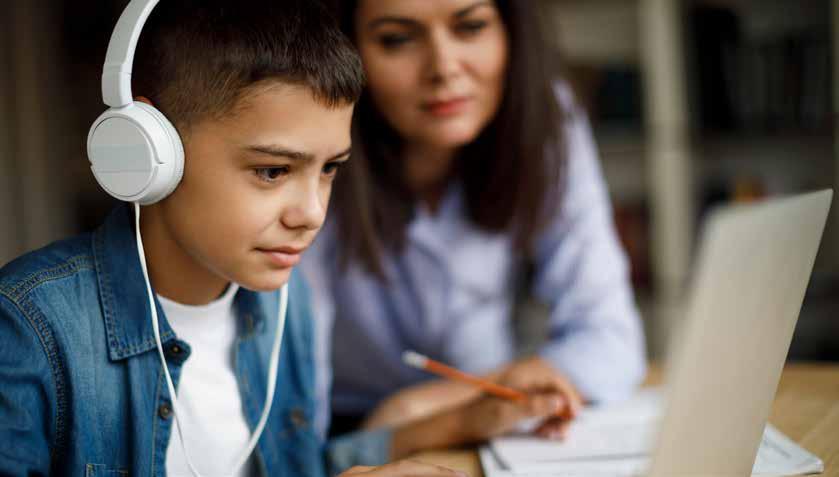
4 minute read
PUBLIC EDUCATION IN UTAH
Utah’s public schools were in a unique position to face the challenges of 2020 and are prepared to build on those successes in the future.
This preparedness begins with having clear vision, purpose and direction. What are the hopes, aspirations and dreams that our community has for young people? What skills and mindsets do young people need to ensure opportunities for their future? A few years ago, the Utah State Board of Education (USBE) engaged in an inclusive strategic planning process that began with addressing these questions. What resulted is Utah’s Portrait of a Graduate — a frame for student success and school quality that goes beyond academic mastery by also recognizing skills like communication and creativity, dispositions like resilience and respect, and other social and emotional dimensions of learning. The Portrait of a Graduate serves as a north star for system transformation. As school districts and charter schools tailor the Portrait of a Graduate for their unique communities, state education leaders aim to create the conditions for school systems throughout the state to intentionally deliver on this powerful vision.
Advertisement
To this end, USBE has adopted goals and strategies for our public education system focused on the following four areas: early learning, effective educators and leaders, personalized teaching and learning, and safe and healthy schools. These goals continue to be a guiding light through the uncertainties of the past year. While we learn and adapt in response to the pandemic, we remain laser-focused on our goals and advancing the aspirations for our students outlined in Utah’s Portrait of a Graduate.
Utah’s forward-looking vision has yielded dividends. Long before the pandemic resulted in the necessity to provide remote and online learning options, state and local education leaders were prioritizing digital teaching and learning. Since 2015, the state has invested in a Digital Teaching and Learning Grant Program. This initiative began with stakeholders from across the state including the local school systems, the Utah State Board of Education, Utah Education and Telehealth Network, and the Legislature creating Utah’s Master Plan to best leverage the power of technology for learning. This plan articulates “Utah has a powerful opportunity to act, and to harness technology as an extraordinary tool to our benefit… To move all students to high levels of learning powered by technology, all students will need access to infrastructure, devices and applications that can be most effectively incorporated into learning… With teachers serving as architects of learning combined with the knowledge to effectively integrate technology, schools can provide students with a pipeline to explore real world concepts, interact with real world experts, and analyze and solve real world problems.” This initiative enabled Utah to transition to
remote learning much more seamlessly scores on the National Assessment of schools that will perpetuate more highly and effectively than other states. Educational Progress with just one skilled employees filling Utah jobs. exception: Utah eighth graders are Most Utah high school students will Online education whether done wholly in the top 20 for math. However, earn some form of college credit before or partially, has long been a choice for those same eighth graders are the top graduation through either Advanced Utah students. High school course performers in the nation in science. Placement courses, concurrent credits have been available through Among the 17 states where the ACT enrollment in Utah colleges, or the online classes in Utah since 1993, college entrance exam is given to all International Baccalaureate Program; making Utah a pioneer in electronic high school juniors, Utah has the best in saving money for Utah families and education. The state offers a statewide the nation average composite score. Our helping students be more prepared for online education program that allows state’s high school graduation rate is post-secondary education. students to gain course credits through pushing toward 90% with seven straight online courses regardless of where years of improvement. We encourage you to learn more about students attend school. Nearly 95% of Utah public schools. Utah has 41 school homes in Utah have a computer and Secondary schools offer a wide variety of districts and over 125 charter schools nearly 90% have broadband internet career and technical education pathways who are responsible for locally operating subscriptions. During the pandemic, integrated with industry needs. A recent Utah’s public schools. You can find Utah schools also provided local hotspot investment by the Utah Legislature contact and link information to all 41 connections and drove buses with Wi-Fi and the technology industry of Silicon districts at schools.utah.gov/schooldistricts. capabilities to fill in some of those gaps. Slopes invested millions of dollars in a You can also find more information computer science initiative for students about individual schools within each Utah’s preparation and clarity of vision and teachers. This strategic investment of the districts, and information about and direction is paying off in terms will ensure that all students, regardless charter schools at schools.utah.gov/of student outcomes. Utah’s fourth of geography, have access to computer schoolsdirectory. Utah students and and eighth graders place in the top 10 science offerings. This is one example educators are on the road to awesome! in reading, mathematics and science of an industry partnership in public JDCS Utah Life ad 2020.pdf 1 12/17/20 8:57 AM


All ages included.
Daycare, Elementary, Middle and High School options available on our Draper and Riverton campuses just minutes from Downtown SLC or Silicon Slopes!
2020, 2019 & 2018 Utah’s Best of State Private School

Learn more & schedule a tour at
be-included.com










